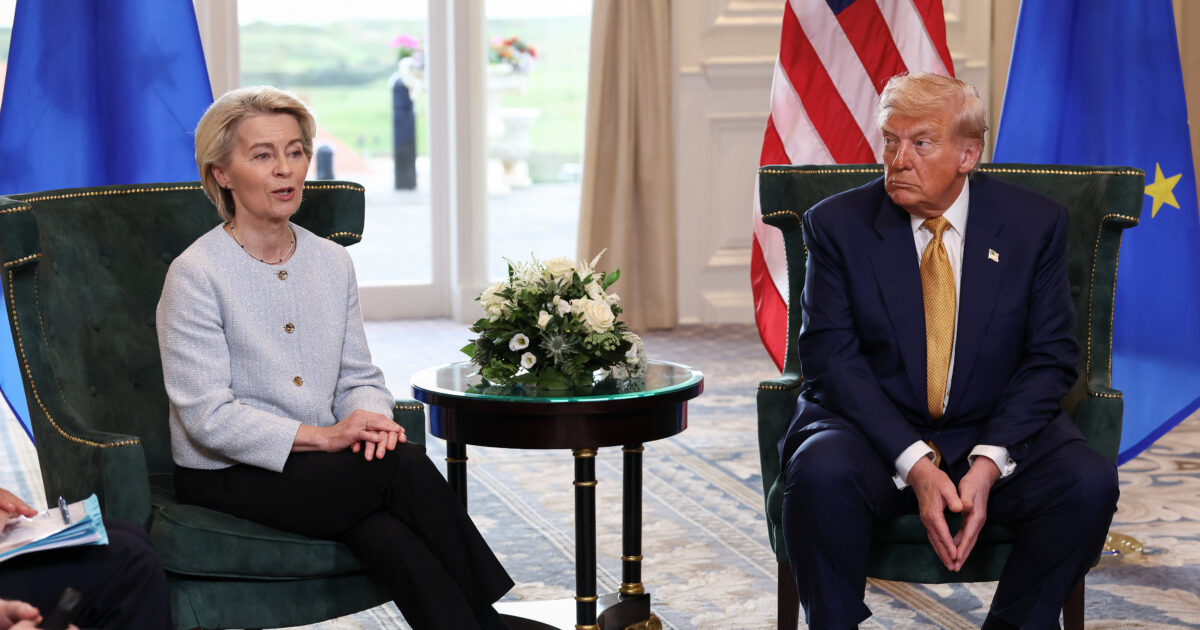Unilaterally against European Union is the package of commercial and investment agreement to which they agreed today USA and eu.
US -EU package predicts first of all, 15% US duties (which will bring $ 85 billion tax revenue to US State) to almost all European imports and Secondly, European investments and purchases totaling $ 1.3 trillion. Dollars ($ 600 billion extra investments in the US and $ 700 billion in energy and weapons markets!). Otherwise, European duties on US imports are left as they are (at most 10% in US cars), while no other EU measures against the US are mentioned.
Overall, the “hike” that the EU will pay to calm down the furious US president reaches the threshold of 1.4 trillion. dollars.
It is recalled that today (27.7.25), US President Donald Trump announced that His country and the European Union (after a meeting with Commission President Ursula von der Laien in Scotland) made a deal Where will the EU see a 15% duty on most of its exports, including cars, preventing a trade war that could have caused a pounding in the global economy.
The deal comes less than a week before Friday, August 1, 2025, for the entry into force of President Donald Trump’s highest duties. The president in May threatened to impose a 50% duty on almost all EU products, adding pressure to the negotiations before reducing the duty to 30%. He said the charge would cover cars. Von de Lien said the rate would be “all inclusive” (along with cars), though Trump later said that it did not include medicinal products and minerals. Steel and aluminum “remain as they are,” the US president added.
However – let’s not forget – that from April 9, 2025, increased US duties apply to European imports of 10% (compared to 2.5% in force for European cars until April 8!). Consequently The 15%, which Ursula von der Laieni agreed with Trump, could not be considered a great “success” on the part of the EU, as it is a six -tasted era.
We now go to the second part of the US -EU Agreement. Ursula von der Laien has agreed to invest an additional $ 600 billion in the US in addition to existing investments, but also to make € 700 billion in energy and equipment purchases!
With this agreement, Bloomberg comments, a (open) trade war is prevented (ed. For the time being) that could have succeeded in the global economy.
The transatlantic agreement eliminates a significant risk to markets and the global economy – a trade war on cross -border trade worth $ 1.7 trillion – although this means that European missions to the US are affected by higher border taxes, according to the same report.
The targets, Trump said, were the largest production in the US and the wider access of US exporters to the European market. Von der Layen acknowledged that part of the effort behind the talks was to review trade, but described it as beneficial to both sides.
“The starting point was an imbalance,” said von der Layen. “We wanted to re -balance the trade we had and wanted to do it in a way that the trade continues between us beyond the Atlantic, because the two largest economies should have a good trade flow.”
US and Europe negotiators had reached an agreement last week. Officials discussed the terms of a rating system for steel and aluminum imports, which would face a lower import tax below a certain limit and be charged with the normal rate of 50% above it. The EU also sought quotas and a ceiling for future tariffs that are specific to the industry, but it is not clear whether the initial agreement will protect the block from potential duties that have not yet been implemented.
US Secretary of Commerce, Howard Latnik, said a decision on semiconductors, who, like drugs, are subject to a continuing survey that opens the door to separate duties, will be examined in about two weeks.
The announcement has completed months of often strained diplomatic relations between Brussels and Washington. The EU had been prepared to impose duties on about 100 billion euros ($ 117 billion) – about one -third of US exports to the Union – if no agreement was reached and Trump followed his warning.
For weeks, the EU has shown its willingness to accept an unbalanced agreement that includes a reduced rate of about 15%, while seeking relief from sectoral duties that are critical to the European economy. The US president has also imposed a 25% duty on cars and twice the coefficient on steel and aluminum, as well as on copper.
Several exporters in Asia, including Indonesia, the Philippines and Japan, have negotiated mutual duties between 15% and 20%.
Washington talks also continue with Switzerland, South Korea and Taiwan.
